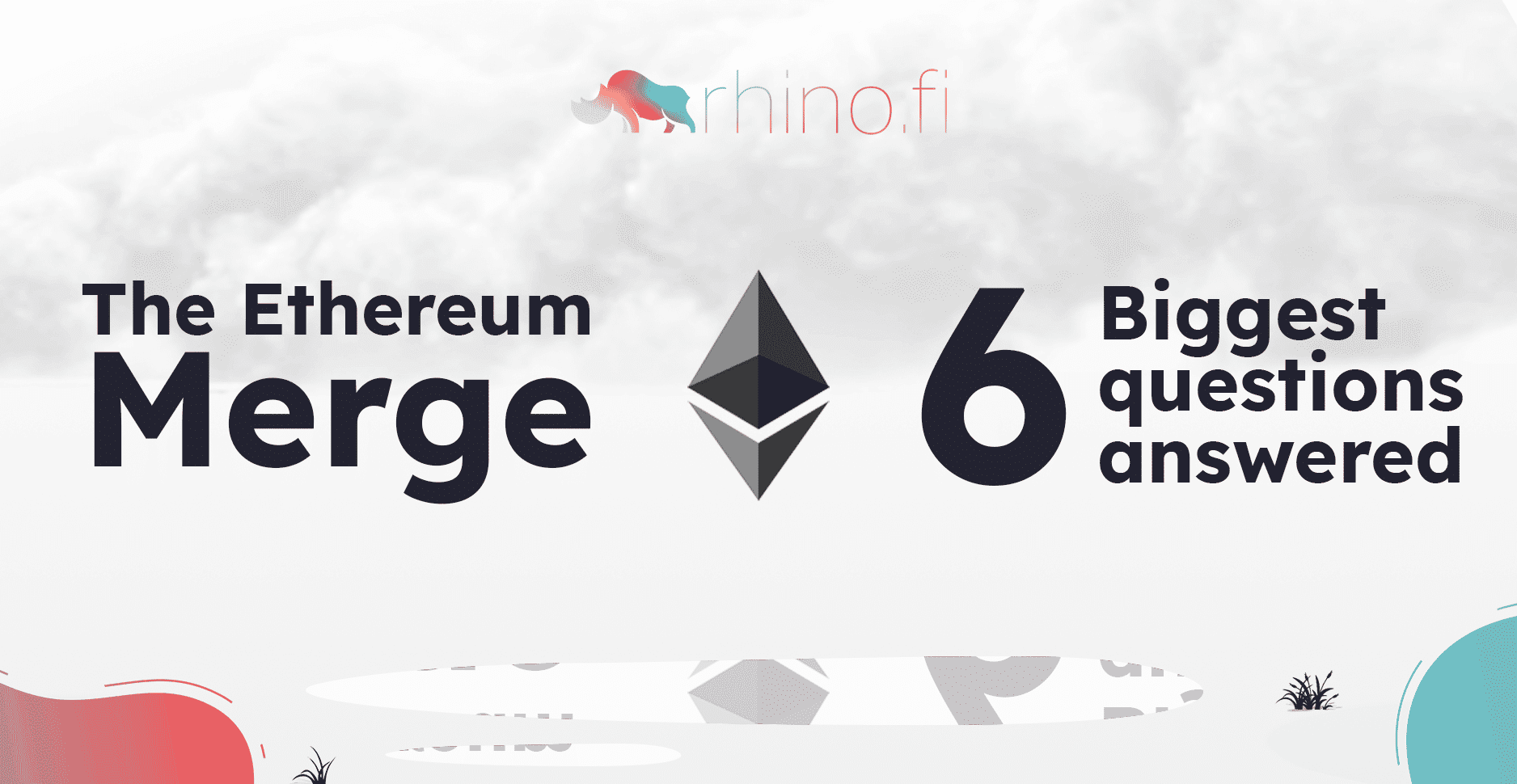The Ethereum Merge has been described as the most significant update in crypto history, and is expected to play a key role in helping blockchain technology achieve mass adoption.
Naturally, this topic has received a flurry of questions. People want to know how the layer 1 Ethereum blockchain will be affected, what the next steps will be after the Merge, and (perhaps most importantly for rhino.fi users) what impact the changes will have on layer 2 and DeFi projects like ours.
In this post, we’re going to answer the six most common questions that our community have been asking, so you have all the information you need to step into Ethereum’s 2.0 future.
1. Proof of Work to Proof of Stake: What will this mean in practice?
The most notable (and highly anticipated) aspect of the Merge is Ethereum’s adoption of a new consensus mechanism for validating transactions and updating the blockchain. But what does this mean for ordinary users?
Until now, Ethereum has relied on proof of work, whereby individual miners race one another to solve cryptographic puzzles and earn the right to update the blockchain.
After the Merge, however, Ethereum will use proof of stake, whereby miners earn the right to update the blockchain by ‘staking’ (depositing) a minimum amount of ETH.
This is a fundamental shift. Whereas previously miners demonstrated their commitment to the project by expending energy in solving puzzles, now they will demonstrate their commitment explicitly by putting their capital into play.
This will have two specific consequences:
- Ethereum will consume significantly less energy. In fact, the amount of energy required to update the blockchain is expected to fall by up to 98%. This will make it much more environmentally friendly.
-
Ethereum will be more economically sustainable. The total supply of ETH will grow very slowly, or potentially even decrease during times of high network usage.
2. How ‘complete’ will Ethereum be after the Merge?
Vitalik Buterin, one of the chief architects of Ethereum, has suggested that the project will be 55% complete after the Merge. What remains to be done?
The great thing about the completion of the Merge is that, for the last few years, it has dominated the attention of most of the top minds working on Ethereum. Once it is complete, these people will be freed up to focus on the next stages of the Ethereum roadmap.
In particular, this will mean focusing on scaling Ethereum with innovations like sharding, the practice of breaking the Ethereum database into smaller segments to spread the load (we’ve got a whole explainer on this topic here).
The next two stages have been dubbed ‘The Purge’ and ‘The Surge’. The Purge will involve fixing and improving many areas of Ethereum’s technical debt to allow it to scale better, tackling the issue of state bloat (the fact that Ethereum’s memory usage has grown too large).
The Surge will focus on making Ethereum faster and cheaper, not simply by using sharding but also adapting the blockchain to better accommodate rollups like rhino.fi, which relieve pressure by bundling transactions into batches and proving them off-chain.
These future changes will be much more impactful, but the Merge had to be completed before they could receive attention.
3. What risks will the Ethereum Merge pose, specifically in terms of stablecoins and forks?
Some commentators have suggested that the Merge will pose a risk to the stability of stablecoins, which is kind of the whole point of them. Others have suggested that a section of the community may ‘fork’ the blockchain — in other words, go off in a different direction – by creating tokens based on the old PoW system. Are these fears justified?
No. All major stablecoins and DeFi protocols have committed to the PoS chain, and therefore there is very little risk to stablecoins or DeFi at the time of the merge.
Some traders and miners have attempted to create a narrative that something more interesting will happen, but this is mainly so they can attempt to profit from it, for example through trading volatility.
Some PoW forks will launch, but these will quickly evaporate. The leading PoW fork has said they will attempt to freeze DeFi pools at the time of the fork, because otherwise they would implode and drive the value of the fork token close to zero. The value is likely to approach zero anyway, despite these changes.
4. Will the Merge give Ethereum an advantage over its competitors?
It has also been suggested that by migrating to the PoS system, Ethereum will gain popularity over other layer 1 blockchains. Will this happen?
Not immediately, since there will be no change as a result of the Merge. Most alternative layer 1 blockchains are already using PoS, and environmentally friendly, so this change will bring Ethereum on par with them.
In the long run, however, this may make it harder for other L1s to compete with Ethereum without having significantly more differentiation.
5. Will the Ethereum Merge reduce the need for Layer 2 solutions?
Layer 2 projects like rhino.fi have played a key role in the wider Ethereum ecosystem over the past few months, allowing users to make transactions more quickly and cheaply. If the L1 Ethereum blockchain is getting more efficient, will this reduce the need for L2s?
Again, no. Ethereum’s scaling roadmap is L2-centric. This means the focus of development for ‘the Surge’ is to increase Ethereum’s throughput using L2s, not instead of L2s.
So much of the future innovation will strive to make Ethereum L1 more useful for L2s. In fact, the Merge and its aftermath will make L2s cheaper. Ethereum will focus on becoming a great settlement layer for rollup data availability, and optimising for this use case.
6. And finally – what is the Merge going to do to DeFi and its users?
Ethereum is the bedrock of decentralised finance. Its smart contracts enable decentralised applications to create sophisticated financial solutions without an old-school intermediary. Surely the Merge will mark a fundamental shift in the way DeFi works?
Actually the Merge won’t affect most DeFi users at all. However, there may be additional benefits for those who’ve staked their ETH assets and received stETH in return.
When you stake your ETH, your assets are given to validators on the network and you receive a share of the rewards they receive (here’s a quick post on how it works). And once the Merge is complete, you may get higher staking rewards; in fact, it is expected that yields could reach 8%.
Which is nice.
And one final thing… what is the Merge going to do to the price of ETH?
Well the answer is we don’t know.
However you can track the price evolution of ETH against other currencies on our trade or swap pages, or get stand-alone price info from CoinGecko.
Got any more questions about the Ethereum Merge? Send us a message on Discord or Twitter and we’ll do our best to answer.





